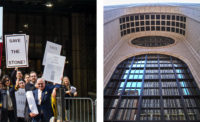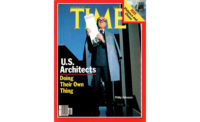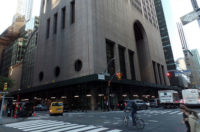Though Philip Johnson and John Burgee’s 1984 AT&T Building is under consideration for landmark status, demolition is underway in the lobby, prompting an outcry from preservationists against not only the development and design teams, but also New York’s Landmarks Preservation Commission (LPC).
The famed lobby—known for its historical finishes, monumental scale, and, until 1992, housing Evelyn Beatrice Longman’s statue nicknamed the “Golden Boy”—was rejected for protected status because of the absence of the statue, alterations, and “its diminished relationship to the overall design of the base,” according to a December 18 letter the LPC sent to preservationist Thomas Collins, who filed an application last fall to designate the lobby.
However, as recently as December 20, the Municipal Arts Society (MAS) had a meeting with a representative from the building’s owner and developer team, Olayan America and Chelsfield, and their historic consultant, Sherida Paulsen, current principal at PKSB Architects and former LPC chair and commissioner, in which Tara Kelly of MAS said the group discussed the preservation of AT&T’s lobby spaces among other elements of the building.
“The conversation was congenial and open,” said Kelly, vice president of the established nonprofit that focuses on preservation and urban planning. But, unbeknownst to her, by the time of their meeting, permits had already been issued to begin work in the lobby. The city issued a work permit for $100,000 worth of “interior demolition” to Spector Group, an architecture and planning firm, on December 15—with LPC approval, as is required for any building under consideration to become a landmark.
“Despite the fact that we expressed our concern to alterations to the lobby,” Kelly says there was no mention of any impending or ongoing work in that interior space. Paulsen confirmed her firm was working for Olayan and Chelsfield, but declined to comment.
The developer-owner team first approached MAS in October 2017, asking for a meeting to show them Snøhetta’s design proposal days before it was released to the public. They then scheduled a follow-up meeting on November 13 to formally explain the proposal to the MAS preservation committee, who sent their letter supporting landmark designation the same day. Though Kelly says they decided not to publicly decry the proposal, the group did raise their concerns in these private meetings.
“We most certainly in every communication with the development team let them know that alterations to the lobby were of concern to us,” she said.
While this was unfolding last fall, more than $2 million in scheduled work was approved to occur within the building. Kelly says MAS was told that most of the work was occurring on the upper stories of the building; the ongoing work did not raise any red flags and, even if it had, there was no legal path to object until the LPC’s November 28 decision to consider the building for designation. After that, any subsequent work permit became subject to the LPC’s review and, according to the LPC’s stated position to RECORD, that meant only reviewing any proposed work to the exterior of the building.
Kelly, and other preservationists engaged in advocating for the building still believed there was time to make a case that could change the LPC’s mind about the interiors, specifically the lobby.
“We were of the thinking that the lobby was still in play,” said Liz Waytkus, executive director of the conservation nonprofit Docomomo US. “The feedback that we heard from Landmarks [was] that the ownership was holding off on moving forward with plans until the landmarking process was over.” Waytkus had been planning to present a proposal for the lobby’s merit with filmmaker and organizer Nathan Eddy at the public hearing.
However, last week around New Year’s, preservationist Thomas Collins, who spent the past two months sending several letters and applications to the LCP in an effort to landmark the building and its lobby, noticed that windows on the ground floor had been taped off, in what seemed like preparation for significant work. The Department of Building’s records of work permits confirmed what he suspected: work could begin any day with the permit issued December 15—proceeding with the LPC’s sign off.
“The proposed work will have no effect on the significant features of the building. Therefore, the staff of the Commission has no objection,” Erica Rothman wrote on behalf of the LPC in response to Olayan-Chelsfield’s application to begin work in the lobby. The owner-developer team confirmed in a statement they were going ahead with work in accordance with “appropriate permits and approvals.”
When Kelly heard the news last week, she was “very dismayed.”
“We entered into a good faith effort to find a favorable solution for everyone and we are disappointed that that’s not what happened here,” she said.
For Simeon Bankoff, executive director at the Historic Districts Council, another preservation organization advocating for the landmarking, the news of the demolition was “extraordinarily disappointing.” He places the responsibility squarely on the shoulders of the LPC.
“It’s being demolished with the permission of the Landmarks Preservation Commission,” he said.
The various preservationists are now turning their attention to preparing for the hearing, which they expect to be scheduled around the end of January—roughly two months after the November calendaring—which many will be attending with a chip on their shoulder.
“We’re going to be adamantly opposed to anything that alters or disfigures Johnson’s original design,” said Collins.








Post a comment to this article
Report Abusive Comment